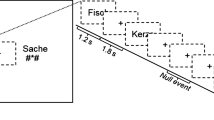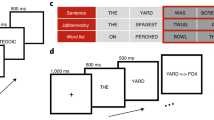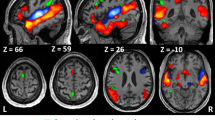Abstract
Reading words and naming pictures involves the association of visual stimuli with phonological and semantic knowledge. Damage to a region of the brain in the left basal posterior temporal lobe (BA37), which is strategically situated between the visual cortex and the more anterior temporal cortex, leads to reading and naming deficits1,2. Additional evidence implicating this region in linguistic processing comes from functional neuroimaging studies of reading in normal subjects3,4,5,6,7 and subjects with developmental dyslexia8,9. Here we test whether the visual component of reading is essential for activation of BA37 by comparing cortical activations elicited by word processing in congenitally blind, late-blind and sighted subjects using functional neuroimaging. Despite the different modalities used (visual and tactile), all groups of subjects showed a common activation of BA37 by words relative to non-word letter-strings. These findings agree with the proposal that BA37 is an association area that integrates converging inputs from many regions10. Our study confirms a prediction of theories of brain function that depend on convergence zones; the absence of one input (that is, visual) does not alter the response properties of such a convergence region.
This is a preview of subscription content, access via your institution
Access options
Subscribe to this journal
Receive 51 print issues and online access
$199.00 per year
only $3.90 per issue
Buy this article
- Purchase on Springer Link
- Instant access to full article PDF
Prices may be subject to local taxes which are calculated during checkout


Similar content being viewed by others
References
Rapcsak, S. Z., Gonzalez Rothi, L. J. & Heilman, K. M. Phonological alexia with optic and tactile anomia: a neuropsychological and anatomical study. Brain Lang. 31, 109–121 (1987).
Damasio, A. R. & Damasio, H. The anatomic basis of pure alexia. Neurology 33, 1573–1583 (1983).
Price, C. J., Wise, R. J. S. & Frackowiak, R. S. J. Demonstrating the implicit processing of visually presented words and pseudowords. Cerebral Cortex 6, 62–70 (1996).
Petersen, S. E., Fox, P. T., Snyder, A. Z. & Raichle, M. E. Activation of extrastriate and frontal cortical areas by words and word-like stimuli. Science 249, 1041–1044 (1990).
Price, C. J. & Friston, K. J. Cognitive conjunction: a new approach to brain activation experiments. Neuroimage 5, 261–270 (1997).
Puce, A., Allison, T., Asgari, M., Gore, J. C. & McCarthy, G. Differential sensitivity of human visual cortex to faces, letterstrings, and textures: a functional magnetic resonance imaging study. J. Neurosci. 16, 5205–5215 (1996).
Bookheimer, S. Y., Zeffiro, T. A., Blaxton, T., Gaillard, W. & Theodore, W. Regional cerebral blood flow during object naming and word reading. Hum. Brain Mapp. 3, 93–106 (1995).
Brunswick, N., McCroy, E., Price, C., Frith, C. D. & Frith, U. Explicit and implicit processing of words and pseudowords by adult developmental dyslexics: a search for Wernicke's Wortschatz? Brain(submitted).
Rumsey, J. M. et al. Apositron emission tomographic study of impaired word recognition and phonological processing in dyslexic men. Arch. Neurol. 54, 562–573 (1997).
Damasio, A. R. & Damasio, H. in Large Scale Neuronal Theories of the Brain(eds Koch, C. & Davis, J. L.) 61–74 (MIT Press, Cambridge, MA, (1994)).
Ungerleider, L. G. & Haxby, J. V. ‘What’ and ‘where’ in the human brain. Curr. Opin. Neurobiol. 4, 157–165 (1994).
Haxby, J. V. et al. Dissociation of object and spatial visual processing pathways in human extrastriate cortex. Proc. Natl Acad. Sci. USA 88, 1621–1625 (1991).
Nobre, A. C., Allison, T. & McCarthy, G. Word recognition in the human inferior temporal lobe. Nature 372, 260–263 (1994).
Luders, H. et al. Basal temporal language area demonstrated by electrical stimulation. Neurology 36, 505–510 (1986).
Burnstine, T. H. et al. Characterization of the basal temporal language area in patients with left temporal lobe epilepsy. Neurology 40, 966–970 (1990).
Farah, M. J. Visual Agnosia(MIT Press, Cambridge, MA, (1990)).
Allison, T., McCarthy, G., Nobre, A., Puce, A. & Belger, A. Human extrastriate visual cortex and the perception of faces, words, numbers, and colors. Cerebral Cortex 4, 544–554 (1994).
Kanwisher, N., McDermott, J. & Chun, M. M. The fusiform face area: a module in human extrastriate cortex specialized for face perception. J. Neurosci. 17, 4302–4311 (1997).
Sadato, N. et al. Activation of the primary visual cortex by Braille reading in blind subjects. Nature 380, 526–528 (1996).
Büchel, C., Price, C. J., Frackowiak, R. S. J. & Friston, K. J. Different activation patterns in the occipital cortex of late and congenitally blind subjects. Brain 121, 409–419 (1998).
Fiez, J. A. et al. PET studies of auditory and phonological processing — effects of stimulus characteristics and task demands. J. Cog. Neurosc. 7, 357–375 (1995).
Martin, A., Haxby, J. V., Lalonde, F. M., Wiggs, C. L. & Ungerleider, L. G. Discrete cortical regions associated with knowledge of color and knowledge of action. Science 270, 102–105 (1995).
Desposito, M. et al. Afunctional MRI study of mental image generation. Neuropsychol. 35, 725–730 (1997).
Suzuki, W. A., Zola-Morgan, S., Squire, L. R. & Amaral, D. G. Lesions of the perirhinal and parahippocampal cortices in the monkey produce long-lasting memory impairment in the visual and tactile modalities. J. Neurosci. 13, 2430–2451 (1993).
De Renzi, E., Zambolin, A. & Crisi, G. The pattern of neuropsychological impairment associated with left posterior cerebral-artery infarcts. Brain 110, 1099–1116 (1987).
Friedman, R. F., Ween, J. E. & Albert, M. L. in Clinical Neuropsychology(eds Heilman, K. M. & Valenstin, E.) 37–62 (Oxford Univ. Press, Oxford, (1993)).
Foundas, A. L., Daniels, S. K. & Vasterling, J. J. Anomia: case studies with lesion localization. Neurocase 4, 35–43 (1998).
Friston, K. J. et al. Statistical parametric maps in functional imaging: a general linear approach. Hum. Brain Mapp. 2, 189–210 (1995).
Acknowledgements
The authors are supported by the Wellcome Trust. We thank A. Brennan, A. Carrol, G. Lewington, J. Galliers and S. Grootoonk for their help with data collection, R. Frackowiak, J. Coull and A. Kleinschmidt for an internal review of this manuscript, and M. Rötger for discussions. We are indebted to our subjects, especially the blind subjects and the Royal National Institute for the Blind in the UK.
Author information
Authors and Affiliations
Corresponding author
Rights and permissions
About this article
Cite this article
Büchel, C., Price, C. & Friston, K. A multimodal language region in the ventral visual pathway. Nature 394, 274–277 (1998). https://doi.org/10.1038/28389
Received:
Accepted:
Issue Date:
DOI: https://doi.org/10.1038/28389
This article is cited by
-
Inter-individual differences in baseline dynamic functional connectivity are linked to cognitive aftereffects of tDCS
Scientific Reports (2022)
-
Cortical recycling in high-level visual cortex during childhood development
Nature Human Behaviour (2021)
-
The Visual Word Form Area compensates for auditory working memory dysfunction in schizophrenia
Scientific Reports (2020)
-
Genetic influence is linked to cortical morphology in category-selective areas of visual cortex
Nature Communications (2020)
-
Abnormal Functional Connectivity Density in Post-Stroke Aphasia
Brain Topography (2019)
Comments
By submitting a comment you agree to abide by our Terms and Community Guidelines. If you find something abusive or that does not comply with our terms or guidelines please flag it as inappropriate.



